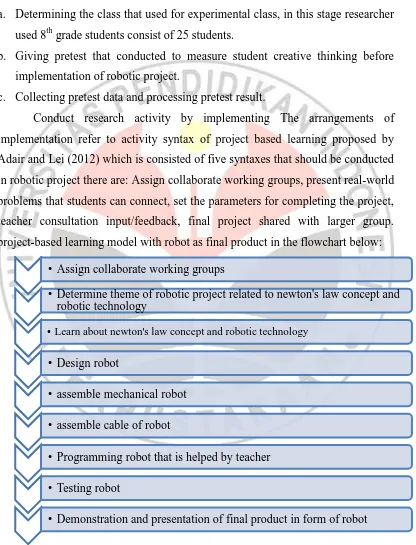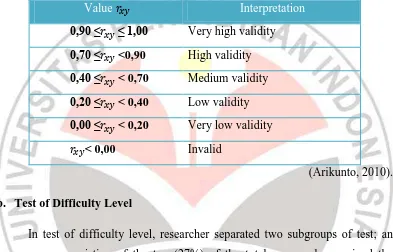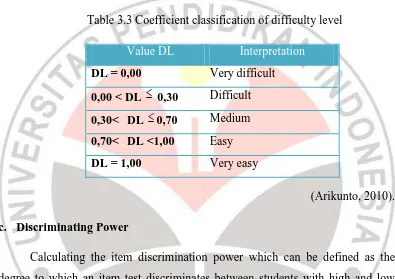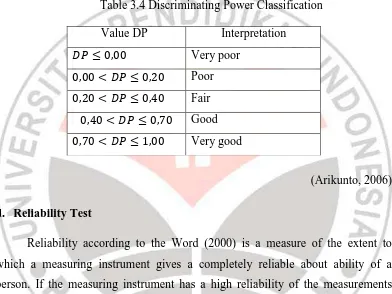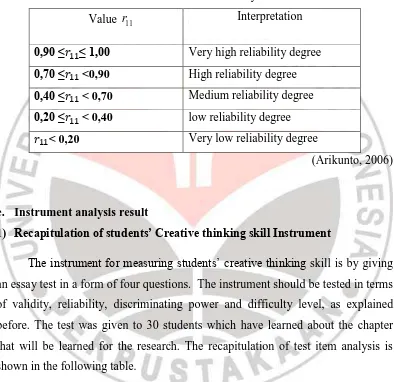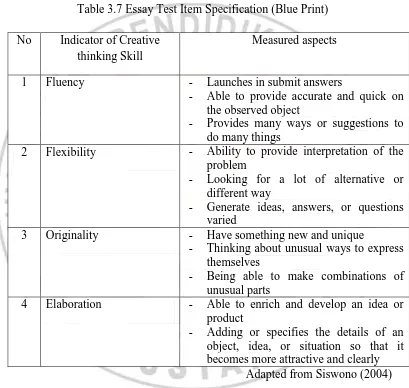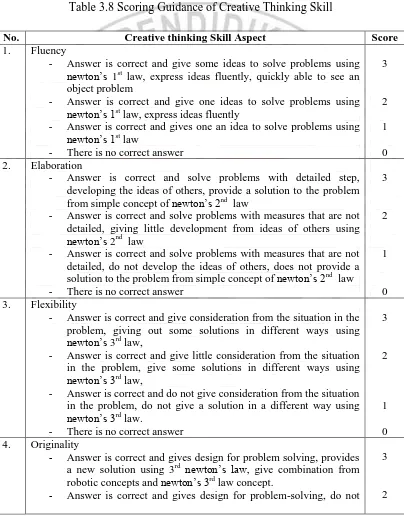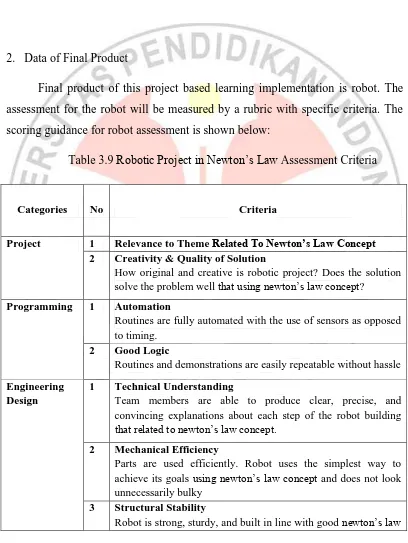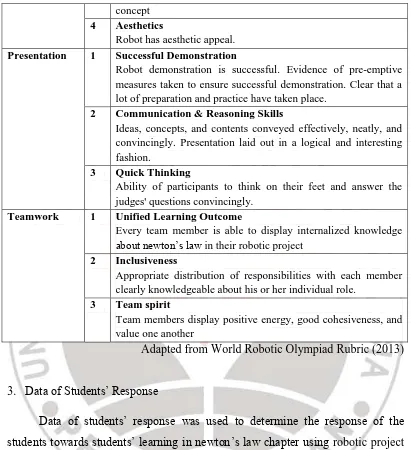Robby Maududy, 2013
ROBOTIC PROJECT AS IMPLEMENTATION OF PROJECT
BASED LEARNING IN THE CONCEPT OF NEWTON’S LAW
TO IMPROVE STUDENTS’ CREATIVE THINKING SKILL
RESEARCH PAPER
Submitted as requirement to obtain degree of Sarjana Pendidikan in
International Program on Science Education Study Program
Created By:
Robby Maududy
0902260
INTERNATIONAL PROGRAM ON SCIENCE EDUCATION
FACULTY OF MATHEMATICS AND SCIENCE EDUCATION
INDONESIA UNIVERSITY OF EDUCATION
Robby Maududy, 2013
ROBOTIC PROJECT AS IMPLEMENTATION OF PROJECT
BASED LEARNING IN
THE CONCEPT OF NEWTON’S LAW
TO IMPROVE STUDENTS’ CREATIVE THINKING SKILL
Oleh
Robby Maududy
Sebuah skripsi yang diajukan untuk memenuhi salah satu syarat memperoleh gelar Sarjana pada Fakultas Pendidikan Matematika dan Ilmu Pengetahuan Alam
© Robby Maududy 2013
Universitas Pendidikan Indonesia
Oktober 2013
Hak Cipta dilindungi undang-undang.
Skripsi ini tidak boleh diperbanyak seluruhya atau sebagian,
Robby Maududy, 2013
APPROVAL FORM OF RESEARCH PAPER
ROBBY MAUDUDY
0902260
ROBOTIC PROJECT AS IMPLEMENTATION OF PROJECT BASED LEARNING IN CONCEPT OF NEWTON’S LAW TO IMPROVE
STUDENTS’ CREATIVE THINKING SKILL
APPROVED AND AUTHORIZED BY:
Supervisor I
Dr. Wawan Setiawan, M.Kom
NIP. 196601011991031005
Supervisor II
Dr. Galuh Yuliani, S.Si., M.Si.
198007252001122001
Head of Study Program of
International Program on Science Education
Dr. Diana Rochintaniawati, M.Ed.
Robby Maududy, 2013
ROBOTIC PROJECT AS IMPLEMENTATION OF PROJECT BASED LEARNING IN CONCEPT OF NEWTON’S LAW TO IMPROVE
STUDENTS’ CREATIVE THINKING
ABSTRACT
Creative thinking skill is important capability that should be owned by each
student in learn newton’s law and its application in new technology. This research
is conducted under the needs of education to solve ineffectiveness of traditional method which could not provide enough facility in developing creative thinking skill and understanding about robotic technology. This research is aimed to investigate improvement of student’s creative thinking skill on newton’s law concept through robotic project, final product of the students in the form of robot as the result of the project in newton’s law concept, students’ response after
implementing robotic project on newton’s law. The method which is used in this research is weak experiment with one-group pretest-posttest design. Sample of research is gained by purposive sampling which sample is students in secondary two in salman alfarisi school. According to research result, it can be concluded
that the improvement of students’ creative thinking skill is categorized as high with n-gain value is 0.75, the result of robotic project has shown positive effect in creativity in doing project and there are other positive effects in constructing programming, engineering design, presentation, and teamwork, Respond of student toward robotic project as implementation of project based learning show positive respond in all indicator; teamwork ability, activity of project based learning implementation, creative thinking skill and making robot as final product.
Key words: Project Based Learning, Robotic Project, Creative Thinking Skill,
Robby Maududy, 2013
ROBOTIC PROJECT AS IMPLEMENTATION OF PROJECT BASED LEARNING IN CONCEPT OF NEWTON’S LAW TO IMPROVE
STUDENTS’ CREATIVE THINKING
ABSTRAK
Keterampilan berpikir kreatif adalah kemampuan penting yang harus dimiliki oleh setiap siswa dalam belajar hukum newton dan penerapannya dalam teknologi baru. Penelitian ini dilakukan atas kebutuhan pendidikan untuk memecahkan kefektifan metode tradisional yang tidak bisa memberikan fasilitas yang cukup dalam mengembangkan keterampilan berpikir kreatif dan pemahaman tentang teknologi robot. Penelitian ini bertujuan untuk mengetahui peningkatan keterampilan berpikir kreatif siswa pada konsep hukum newton melalui proyek robot, produk akhir dari siswa dalam bentuk robot sebagai hasil dari proyek dalam konsep hukum newton, tanggapan siswa setelah pelaksanaan proyek robot pada hukum newton. Metode yang digunakan dalam penelitian ini adalah weak eksperimen lemah dengan satu kelompok desain pretest-posttest. Sampel penelitian diperoleh secara purposive sampling yang sampel siswa di SMP salman alfarisi. Berdasarkan hasil penelitian, dapat disimpulkan bahwa peningkatan kemampuan berpikir kreatif siswa dikategorikan tinggi dengan nilai n-gain adalah 0,75, hasil dari proyek robot telah menunjukkan efek positif dalam kreativitas dalam melakukan proyek dan ada efek positif lainnya dalam membangun pemrograman, desain teknik, presentasi, dan kerja sama tim, Tanggapan siswa terhadap proyek robot sebagai implementasi pembelajaran berbasis proyek mendapat respon positif di semua indikator, kemampuan kerja sama tim, kegiatan pelaksanaan pembelajaran berbasis proyek, keterampilan berpikir kreatif dan membuat robot sebagai produk akhir .
Robby Maududy, 2013
TABLE OF CONTENTS
APPROVAL FORM DECLARATION
PREFACE ... i
ACKNOWLEDGEMENT ... ii
ABSTRACT ... iv
TABLE OF CONTENT ... v
TABLE LIST ... vii
FIGURE LIST ... ix
APPENDIX LIST ... 1
CHAPTER I INTRODUCTION A. Background ... 1
B. Research Problem ... 4
C. Research Question ... 4
D. Problem Limitation ... 4
E. Research Objective ... 5
F. Research Significance ... 5
G. Organization Structure of Research Paper ... 6
CHAPTER II PROJECT BASED LEARNING, ROBOTIC PROJECT, CREATIVE THINKING SKILL, AND NEWTON’S LAW A. Project Based Learning ... 7
B. Robotic Project ... 13
C. Creative Thinking Skill ... 22
D. Newton’s Law ... 27
CHAPTER III RESEARCH METHODOLOGY A. Location, Subject and population of Research ... 36
Robby Maududy, 2013
C. Research Method ... 37
D. Operational Definition ... 42
E. Instructional Tool ... 43
F. Research Instrument ... 44
G. Process of Instrument Development ... 44
H. Data Collection Technique ... 50
I. Data Analysis technique ... 55
CHAPTER IV RESULT AND DISCUSSION A. Result ... 60
B. Discussion ... 82
CHAPTER V CONCLUSSION AND RECOMMENDATION A. Conclusion ... 91
B. Recommendation ... 91
BIBLIOGRAPHY ... 93
Robby Maududy, 2013
TABLE LIST
3.1. The one group pretest-posttest ... 36
3.2. Classification validity coefficient ... 46
3.3. Coefficient classification of difficulty level ... 47
3.4. Discriminating Power Classification... 48
3.5. Classification of Reliability Coefficient... 49
3.6. Recapitulation of test item for students’ creative thinking skill ... 49
3.7. Essay Test Item Specification (Blue Print) ... 51
3.8. Scoring Guidance of Creative Thinking Skill ... 52
3.9. Robotic Project in Newton’s Law Assessment Criteria ... 53
3.10. Specification Students’ Response Questionnaire ... 55
3.11. Interpretation of Normalized Gain Value ... 57
3.12. Percentage Interpretation ... 58
3.13. Interpretation student response ... 59
4.1. Observation result of students’ activity... 63
4.2. Recapitulation of Students’ Creative Thinking Skill ... 66
4.3. Recapitulation improvement scores in every aspect of creative thinking skill ... 67
4.4. robotic product of each group ... 70
4.5. Recapitulation of group score in robotic project ... 72
4.6. Recapitulation of Project Category in robotic project... 74
4.7. Recapitulation of Programming Category in robotic project ... 75
4.8. Recapitulation of Engineering design Category in robotic project ... 76
Robby Maududy, 2013
4.10. Recapitulation of Presentation Category in robotic project ... 78
Robby Maududy, 2013
FIGURE LIST
2.1. Robotic technology ... 14
2.2. Mobile robot ... 15
2.3. Network robot ... 16
2.4. Manipulator robot... 16
2.5. Humanoid robot ... 17
2.6. Legged robot ... 18
2.7. Flying robot ... 18
2.8. Under water robot ... 19
2.9. Straight line motions ... 29
2.10. Seat belt ... 30
2.11. Newton’s Third Law (Action-Reaction) ... 33
3.1. Diagram of Research Plot ... 38
3.2. Diagram of Robotic Project ... 40
4.1. Chart of Percentage of students’ activity during the implementation ... 64
4.2. Chart of Improvement score in every aspect of creative thinking skill ... 68
4.3. Excavator robot ... 70
4.4. Probing Robot ... 70
4.5. Quadruped Robot ... 70
4.6. Chart of Percentage of Robotic Project Category ... 74
Robby Maududy, 2013
APPENDIX LIST
A.1. Lesson Plan ... 96
A.2. Robotic Module A.2.1. Excavator Robot Module ... 112
A.2.2. Quadruped Robot Module ... 130
A.2.3. Probing Robot Module ... 143
A.3. Students’ Group Worksheet ... 156
B.1. Creative thinking test blue print ... 160
B.2. Creative Thinking Assessment Scale ... 165
B.3. Creative thinking test draft ... 167
B.4. Robotic Project Rubric ... 168
C.1. Observation Sheet C.1.1. Observation Sheet of 1st Meeting ... 174
C.1.2.Observation Sheet of 2nd Meeting ... 177
C.1.3.Observation Sheet of 3rd Meeting ... 180
C.1.4.Observation Sheet of 4th Meeting ... 183
C.2. Students’ Questionnaire C.2.1. Blue Print of Students’ Questionnaire ... 187
C.2.2. Students’ Questionnaire Draft ... 188
D.1. Instrument Analysis of Creative Thinking Test ... 191
D.2. Data Interpretation of Creative thinking test Analysis ... 195
E.1. Data Analysis of Pretest ... 196
E.2. Data Analysis of Posttest ... 197
Robby Maududy, 2013
E.4. Data Analysis of Robotic Project ... 200
E.5. Questionnaire Analysis ... 203
E.6. Analysis of Teacher Observation Sheet E.6.1. Analysis of Teacher Observation Sheet in 1st Meeting ... 205
E.6.2. Analysis of Teacher Observation Sheet in 2nd Meeting ... 206
E.6.3. Analysis of Teacher Observation Sheet in 3rd Meeting ... 208
E.6.4. Analysis of Teacher Observation Sheet in 4th Meeting ... 210
E.7. Analysis of Students’ Observation Sheet E.7.1. Analysis of Students’ Observation Sheet in 1st Meeting... 212
E.7.2. Analysis of Students’ Observation Sheet in 2nd Meeting ... 213
E.7.3. Analysis of Students’ Observation Sheet in 3rd Meeting ... 215
E.7.4. Analysis of Students’ Observation Sheet in 4th Meeting ... 217
F.1. Covering Letter of Research ... 218
F.2. Annotation Letter of Research ... 219
F.3. Judgment Sheet ... 220
Robby Maududy, 2013
CHAPTER I
INTRODUCTION
A. Background
Learning objectives is not only understood the concepts and principles, but also makes the students have the ability to apply the concepts and principles that
have been understood in daily life. In that regard, the system of education, including learning and assessment of learning outcomes is expected to change the learning pattern from teacher-centered and subject matter oriented to student centered and oriented to the development of life skills, Thinking skills, social skills, academic skills, and vocational skills (Ministry of Education, 2003).
Learning science including physics is not only the acquisition of knowledge in the form of facts, concepts, principles or theories, but learning will be more meaningful if the students have experiences from learning science. (Ausubel Learning Theory, 1968).
Learning of physics including concept of Newton’s law, according to the vovi vatmawati yuli research (2008) this concept is difficult to understand because students just listen to the teacher's explanation and did not apply the concept of Newton’s law in everyday life. Learning the concept of Newton’s law is also required to solve a problem in everyday life, in solving problems in everyday life students should have creative thinking, The importance of creativity contained in the System of National Education No. 20 of 2003, which in essence is through education among others are expected to develop the potential of students to be a righteous man, noble, competent, creative, and independent.
According to Utami Munandar (2004) based on the results of a survey
conducted Indonesian Education Sector Survey Report, explained that education in Indonesia emphasis on routine skills and sheer memorization. Students are
2
Robby Maududy, 2013
allowed, it means if the student continues to be restrained by the teacher in the learning process, it is feared will impact negatively on the improvement of students' creativity, and creativity is important to improve. To cope these things need to be applied a learning model that can improve creative thinking skill, one of which is Project-Based Learning.
Project Based Learning is an approach to instruction that emphasizes “authentic learning tasks grounded in the personal interests of learners” (Grant, 2009, p. 1). The Buck Institute for Education calls PBL “a systematic teaching method that engages students in learning knowledge and skills through an extended inquiry process structured around complex, authentic questions and carefully designed products and tasks.” (Markham, 2003, p. 4). However it is defined, Project Based Learning presents students with real world, multidisciplinary problems that demand critical thinking, engagement, and collaboration.
Results from Siti Nurhayati Sufyani research (2010) on learning concluded that the project-based classroom-based emotional intelligence project significantly better than classes and class encapsulates practical, creative thinking capability data showed an average increase in with a summary of learning through the creation of 0.45 (medium), assisted learning lab at 0.38 (medium) and projects based learning of 0.50 (medium).So Project-based learning experiences will help teacher figure out how to make learning come alive for students. Project based learning make students are actively engaged in inquiry work, where they are reading, talking, questioning, analyzing and creating products, in large groups, small groups, independently toward the goal of demonstrating their learning based on self-selected compelling questions and topics in physics.
One of efforts to overcome above problems is by implement meaningful
3
Robby Maududy, 2013
Robotics projects will be adopted as the implementation of project based learning. The Robotic project seeing the development of the technology world is currently growing very rapidly in various scientific fields, one of which is the field of robotics. Robotics technology has been applied ranging from industry to education, researchers who have experience in the world of robotics, students, until the children are mostly as users only. As it grows, robotics technology has
become one of the media and educational games for elementary school students to high school. Therefore the robotic project as a platform to introduce robotics technology in the next generation early.
Students who are the subject of research are Student in Salman Alfarisi School Bandung. From the preliminary study in junior high school, especially in the Salman Alfarisi School Bandung, there is a robotics club which consists of students who study about the robot. So, it is possible for students to perform robotic project and incorporate concepts of Newton’s law in the robotics project. Students in initially does not know the relationship between concept of Newton’s law and robot technology. This robotic project can help student to understand the concept of Newton’s law that exist on the robot.
In research that will be conducted, the concept of Newton’s law is used as teaching materials that will be studied in this research. This concept of Newton’s law is possible to implement project-based learning with the robot as a project that can be directly performed by the students, so that project-based learning activities through this activity can still be performed. In addition, these teaching materials have quite a lot of applications in industry and housing, such as the working principle of mobile robot and humanoid robot using the concepts of Newton’s law. This Method is expected to result in meaningful learning, more applicable
learning and improve student creative thinking skill.
4
Robby Maududy, 2013
mastery of Newton’s law by creating, and presenting, a research-based project that is driven by their own interest in a topic and allows them to work within the same parameters as real researchers.
B. Research Problem
Based on the background of the issues outlined above, the problems in this study can be formulated in the form of a question
as follows: “How is the improvement of students’ creative thinking skill through robotic project as implementation of project based learning?”
C. Research Question
Based on research problem in this context analysis of project based learning in learn concept of Newton’s law is focused on three main questions. They are:
1. How is the improvement of student’s creative thinking skill on Newton’s law
concept through robotic project as implementation of project based learning? 2. How is the final product of the students in the form of robot as the result of
the project in Newton’s law concept?
3. How is students’ response after implementing robotic project on Newton’s law concept as implementation of project based learning to improve students’ creative thinking skill?
D. Problem Limitation
To be more focused research, the research is limited to the method of learning, the development of creative thinking, student learning activities, the project that implemented on implementation of the learning model with the following limitations:
1. The learning model used is the model of project based learning.
2. Increased creative thinking, increase referred to in this study is an increase in
5
Robby Maududy, 2013
3. Content that is implemented is newton’s law concept for junior high school. 4. Student activity involvement is limited to the making of the project, the
project is implemented within the project-based learning is a robotic project.
E. Research Objective
Generally, this research aims to find a solution of problem solving in learning process of newton’s law concept. The study specifically aims as follows:
1. To obtain the data about the improvement of student’s creative thinking skill on newton’s law concept through robotic project as implementation of project based learning
2. To obtain the data about final product of the students in the form of robot as
the result of the project in Newton’s law concept.
3. To obtain the data about students’ response after implementing robotic
project on Newton’s law concept as implementation of project based learning to improve students’ creative thinking skill.
F. Research Significance
The study is expected to provide benefits for students, teachers, schools and other educational institutions.
1. For students, through this research are expected students to improve creative
thinking skill on the concept of Newton’s law.
2. For teachers, this research is expected to provide input about learning
strategies in an effort to improve creative thinking skill on concepts of Newton’s law.
3. For schools and other educational institutions, this research is expected to be
used as information and studies in the development of learning science
6
Robby Maududy, 2013
G. Organization Structure of Research Paper
To simplify the discussion and drafting research reports, following the author plans to make the organizational framework of the research described by systematic writing as follows:
Chapter I Introduction, including background, research problem, research
question, problem limitation, research objective, research significance and organization structure of research paper.
Chapter II literature review, including description of basic theory of the research. This research is reviewing project based learning, robotic project, creative thinking skill, and concept of Newton’s law.
Chapter III research methodology, discuss about location, subject, and population of research, research design, the research methods, operational definition, instructional tool, research instrument, process of instrument development, data collection techniques, and data analysis techniques.
Chapter IV results and discussion, contains the data processing, the discussion and analysis of research data.
Robby Maududy, 2013
CHAPTER III
RESEARCH METHODOLOGY
A. Location, Subject and population of Research
The research was conducted in in Salman Al-Farisi School Bandung which applied national curriculum in learning process. The data collection was done in September 2013. Population of this research is all students’ ability in creative
thinking skill in secondary two. The sample is all students’ in creative thinking skill on newton’s law chapter and consists of 25 students. The sampling technique of this research is purposive sampling.
B. Research Design
Design used in this study was one group pretest-posttest design (Fraenkel and Wallen, 2008). Designs can be described as follows:
Table 3.1 The one group pretest-posttest
Pre-Test Treatment Post-Test
Subject A1 X A2
Description:
A1 : Pre-test
A2 : Post-test
X : Robotic Project in Project based learning
There are three steps taken in this design are:
1. Provide pre-test to measure creative thinking of students early before
given treatment.
2. Provide treatment of robotic project as implementation of project based
37
Robby Maududy, 2013
3. Provide post-test to measure creative thinking of students after treatment.
The difference in the value of the difference between the initial test and final test is assumed to be the effect of robotic project as implementation of project based learning in newton’s law concept to develop student creative thinking.
C. Research Method
Research method that will be conducted is a study weak experiment on robotic project as implementation of project-based learning in concept of newton’s law to develop student creative thinking. The method is used because this method is the most suitable to the condition which the research subjects were examined only in one class and does not use using control class for comparison (Arikunto, 2006).
38
Robby Maududy, 2013
Preliminary study on
learning
of newton’s
law concept
Study of robotic project as
implementation of project based
learning
Study of creative thinking
Study of
newton’s law
concept
Formulate the problem and research objectives
Making indicators creative thinking
Instrument Making and designing learning model
Pretest
Implementation of Project based learning using robotic project
Postest
Data Analysis
Conclusion
Testing and revision of the instrument
Observation Preparation stage
Implementation stage
Final stage
Figure 3.1 Diagram of Research Plot
Procedure of research is arranged based on the syntax of project-based
39
Robby Maududy, 2013
procedure consists of preparation stage, implementation stage, and analysis and conclusion stage. The procedure could be explained as follows:
1. Preparation Stage
In this stage, the researcher conduct several steps that support the research, there are:
a. Formulating problem that will be investigated, in this step there are problem
that must be solve, so this research would solve problem in learning about concept in newton’s law.
b. Determining the focus of variable research
c. Conducting literature review of newton’s law concept, project-based learning,
robotic project, creative thinking skill, and curriculum.
d. Arranging the research proposal which is presented in proposal seminar
e. Revised of research proposal after having suggestions and critics from
lecturers.
f. Arranging the research instrument and being judged by expert or lecturer.
Instrument that used are essay test that measured creative thinking, rubric form to measured final product in form of robot, questionnaire to measured student respond in implementing robotic project, and note observation to observe student activity in implementation of robotic project.
g. Arranging instructional tool which are including lesson plan, robotic project
module, worksheet of robotic project, and robotic part that will be used in robotic project.
h. Revised of research instrument after having suggestions.
i. Testing of research instrument, researchers implement this step to 9th grade of
junior high school of salman alfarisi.
j. Revised of research instrument based on instrument try out analysis result
40
Robby Maududy, 2013
During implementation stage, it will be observed the robotic project as implementation of project based learning. Implementation conducted several stages that include:
a. Determining the class that used for experimental class, in this stage researcher
used 8th grade students consist of 25 students.
b. Giving pretest that conducted to measure student creative thinking before
implementation of robotic project.
c. Collecting pretest data and processing pretest result.
Conduct research activity by implementing The arrangements of implementation refer to activity syntax of project based learning proposed by Adair and Lei (2012) which is consisted of five syntaxes that should be conducted in robotic project there are: Assign collaborate working groups, present real-world problems that students can connect, set the parameters for completing the project, teacher consultation input/feedback, final project shared with larger group. project-based learning model with robot as final product in the flowchart below:
Figure 3.2 Diagram of Robotic Project • Assign collaborate working groups
• Determine theme of robotic project related to newton's law concept and robotic technology
• Learn about newton's law concept and robotic technology
• Design robot
• assemble mechanical robot
• assemble cable of robot
• Programming robot that is helped by teacher
• Testing robot
41
Robby Maududy, 2013
The implementation of robotic project could be explained as follows:
1) First Meeting, teacher inform that in the end of the chapter students should make a robotic project in a group related to newton’s law concept and robotic technology. In this meeting teacher give explanation about newton’s law concept, robotic technology, application of newton’s law concept in robotic technology and gives some video that apply newton’s
law concept in robot.
2) Second meeting, teacher give explanation about newton’s law concept and
component of robotic technology. In this meeting student should understand about newton’s law concept and robotic technology before making robotic project that apply robotic technology and newton’s law concept. Teacher give explanation about robotic component that should have by robot and show robot in the class and give explanation about robotic technology and newton’s law concept that used in the robot.
3) Third meeting, teacher describes the robotic project that will be conducted,
in this meeting teacher choose group member consist of high-low ability achievement (8-9 students), teacher distributes individual worksheet as guidance and give one sample of product that used newton’s law concept and robotic technology, teacher ask student to determine robot that will be made by student, students find literature in concept of newton’s law that can be used as a literature in completing the robotic project and design the robotic project. After that student design the robot that used concept of newton’s law and robotic technology, student design based on the available materials, in this project there are 3 groups with different theme
of robotic project. Robotic guidance is made by teacher to make student easier in making robot, after student determine the theme of robot, student
42
Robby Maududy, 2013
project work plan such as material, procedure and the concept that related to the robotic project.
4) Fourth Meeting, Students working on the project. Students do their robotic
project and teacher guide student in making robotic project. Teacher give worksheet to fill it based on robotic project. Student followed the robotic guidance and consult about the project. In making robot, students only
assemble the mechanical of robot and cable of robot, but programming of the robot is programmed by teacher. After student has finished doing their robot, each group shows their robotic project and presentation of robotic project. And teacher gives suggestion of the robotic project. Teacher gives assessment for robotic project in form of robotic project rubric.
d. Give posttest that conducted to measure student creative thinking after
implementation of robotic project.
e. Give questionnaire to know the student’s response towards implementation of
project-based learning in the whole learning. 3. Final stage
1) Data Analysis
All Data is collected and then data is analyzed and make some discussion in Implementation of robotic project in concept of newton’s law to develop student creative thinking.
2) Conclusion
After analyze the data, it make conclusion about robotic project as implementation of project based learning in concept of newton’s law to develop student creative thinking.
D. Operational Definition
Explanation of the term is intended to describe the meaning of the various concepts used in this study, so hopefully will not cause different interpretations. 1. Robotic Project is a project that starts by design and create a robot,
43
Robby Maududy, 2013
used robot is a robot that uses the concept of newton’s law and robotic technology.
2. Project Based Learning is a learning method that uses problems as a first step
in collecting and integrating new knowledge based on their experiences in real activity. Through the act of investigation or research which indirectly students understand the concepts and principles of a discipline and produce a product
to be presented
3. Student develop creative thinking is the development of students' ability to
generate new ideas and products, see a pattern or a new relationship between one thing and another thing that originally did not seem that finding new ways to express one thing, combining existing ideas to generate new ideas and better. Creative thinking abilities reflected in four aspects there are fluency, flexibility, originality and elaboration.
E. Instructional Tool
Instructional tool that is used in the implementation of this research are enlisted as follows:
1. Lesson Plan
Lesson plan is design of instructional arrangement that will be used in the implementation of robotic project. These arrangements of lesson plan refer to syntax of project based learning proposed by Adair and Lei (2012). There are mainly five syntaxes that should be conducted in robotic project there are :Assign collaborate working groups, present real-world problems that pupils can connect, set the parameters for completing the project, teacher consultation input/feedback, final project shared with larger group. Lesson plan arranged according to learning objective stated in national curriculum for concept of newton’s law. Accordingly arrangement of lesson plan can be seen in appendix A.1
2. Robotic Project Module
44
Robby Maududy, 2013
guidance during project. There are three robotic modules that used in project there are:
a. Excavator robot module
b. Quadruped Walking Robot module c. Probing Robot module
The module consists of material, tool and procedure that is used in making
robot. Draft of robotic project module can be seen in appendix A.2 .
F. Research Instrument
The instrument used to obtain the data in this study consists of: 1. Creative thinking test
Creative thinking test in form of essay is used to measure students’ creative thinking skill. Teacher will mark the rubrics based on students’ answer and calculate it as final result. The rubrics will determine the aspect of creative thinking skill that students have based on each essay question given. Draft of Creative thinking test can be seen in appendix B.3.
2. Rubrics form
Rubrics form for assessing the final product in of the project-based learning. The final product is in a form of robot, the robot will be analyzed based on rubrics criteria. Draft of Rubrics form can be seen in appendix B.4.
3. Questionnaire
Questionnaire in this study is designed to determine students' responses to robotic project that has been applied as well to know the advantages and disadvantages of robotic project as implementation of project based learning. Draft of Questionnaire can be seen in appendix C.2.2.
4. Note observations
45
Robby Maududy, 2013
G. Process of Instrument Development
This research was conducted using a test instrument in writing in the form of essay, questionnaire, and observation notes. Before the first test item made lattice prepared to determine the suitability of indicators about the mastery of concepts and contents lattice with the test item. The instrument needs to be consulted (judgment) by the concerned lecturer and some experts in related fields.
After being judged, the instrument which is not appropriate enough should be revised. After the instrument revised, it should be tried out on another class which has the same level of research sample. Based on the test results, the instrument questions will be analyzed with the following requirements:
1. Instrument Test Requerments a. Questions Validity Test
In this research needs to test the validity of the questions so that appropriate assessment tools to the concept being assessed. According Sudjana (2011), validity with respect to the accuracy of the assessment tool is assessed so that the concept really assesses what should be assessed. After the first validity test by expert lecturers, the questions the students tested outside the study subjects who had been getting the concept to be taught. According Arikunto (2009) a data or information can be said to be valid in accordance with our actual results. The test is called valid if the test can measure what it intends to measure. Validity is sought is the validity item. Technique that used to measure the validity of the test is the product moment correlation technique proposed by Pearson. Here is the Pearson product moment correlation formula:
rxy= n
x y (
x) (
y )[n
x 2(
x) 2 }{n
y 2 (
y ) 2 ](Sudjana, 2005)
Description:
46
Robby Maududy, 2013
n = number of participants test
X = score of students at each items
Y = total score
Interpretation about will be divided into different categories based on
Guilford (Arikunto,2010).
Table 3.2 Classification validity coefficient
Value Interpretation
b. Test of Difficulty Level
In test of difficulty level, researcher separated two subgroups of test; an upper group consisting of the top (27%) of the total group who received the highest scores, and a lower group including an equal number of tests (27%) who received the lowest scores. The researcher also counted the number of times each response to each item is chosen correctly on the test of the upper group and does the same separately for the papers of the lower group. So, it intended to calculate the difficulty level of each item. It means as Gronlund (1976:211) remarks “the percentage of students who got the item right”; so, in order to find out the level of difficulty for each item in the test, the following formula has been used:
47
Table 3.3 Coefficient classification of difficulty level
(Arikunto, 2010).
c. Discriminating Power
Calculating the item discrimination power which can be defined as the degree to which an item test discriminates between students with high and low achiever. Discriminating power of test item is the ability of test item to distinguish between a high achiever and low achiever student (Arikunto, 2006). So, to obtain the discrimination power of the items, the following formula has been used:
T
RU = The number of tests in the upper group who got the item right.
48
Robby Maududy, 2013
RL = The number of tests in the lower group who got the item right.
T = The total of tests included in item analysis.
Classification of discriminating power interpretation used is:
Table 3.4 Discriminating Power Classification
(Arikunto, 2006)
d. Reliability Test
Reliability according to the Word (2000) is a measure of the extent to which a measuring instrument gives a completely reliable about ability of a person. If the measuring instrument has a high reliability of the measurements were performed repeatedly with the measuring instrument to the same subject in the same condition in the same conditions will produce the same information or the same approach. One of the ways to calculate the reliability of a test without splitting the two tests is by using the Kuder-Richardson 20 formula, with the formula:
∑ ]
(Arikunto, 2006) Description:
k = number of question
Value DP Interpretation
Very poor
49
Robby Maududy, 2013
p = proportion of correct responses to a question q = proportion of incorrect responses to a question s2 = variance of test scores
Table 3.5 Classification of Reliability Coefficient
Value r11 Interpretation
0,90 ≤ ≤ 1,00 Very high reliability degree
0,70 ≤ <0,90 High reliability degree
0,40 ≤ < 0,70 Medium reliability degree
0,20 ≤ < 0,40 low reliability degree
< 0,20 Very low reliability degree
(Arikunto, 2006)
e. Instrument analysis result
1) Recapitulation of students’ Creative thinking skill Instrument
The instrument for measuring students’ creative thinking skill is by giving an essay test in a form of four questions. The instrument should be tested in terms of validity, reliability, discriminating power and difficulty level, as explained before. The test was given to 30 students which have learned about the chapter that will be learned for the research. The recapitulation of test item analysis is shown in the following table.
Reliability: 0.65 (Medium reliability degree)
Table 3.6 Recapitulation of test item for students’ creative thinking skill
Question Number
Discriminating
Power Difficulty Level Validity Status
50
Robby Maududy, 2013
2 Good Difficult High Used
3 Fair Difficult Medium Revised
4 Fair Difficult Medium Revised
Question number 3 and 4 are revised because discrimination power is fair and validity is medium and difficulty level for this question is difficult so it should be revised, question number 1 and 2 are used because discrimination power is good and validity is high and difficulty level for this question is difficult.
2) Instrument non-test requirements a. Rubrics
The rubrics will be used to observe the final result of students’ project in newton’s law chapter. The final result of students’ project is in form of robot. The robot will be assessed into some criteria which is available in the rubrics. It will be used in the last meeting of the chapter as additional mark. The rubrics made by the observer after being judged with certain scale to measure the result, the rubrics will be fulfilled by the researcher as well as the observer.
b. Questionnaire
Questionnaire is used to know the response of the students towards robotic project as implementation of Project-Based Learning model in newton’s law chapter during the lesson. This data obtained from students’ answer from 27 questions given in the end of the lesson.
H. Data Collection Technique
In this research, there are three different data which is collected, those data has different instrument to measure. The data collection techniques are explained as follow:
51
Robby Maududy, 2013
Creative thinking skill result will be gained from four essay questions. The answer of students in the test will be analyzed in specific rubrics. The rubrics will show whether the students have already mastering the skill or not. The rubrics display the leveling of each student who answering the essay test.
Table 3.7 Essay Test Item Specification (Blue Print)
No Indicator of Creative thinking Skill
3 Originality - Have something new and unique
- Thinking about unusual ways to express themselves becomes more attractive and clearly
Adapted from Siswono (2004)
52
Robby Maududy, 2013
Table 3.8 Scoring Guidance of Creative Thinking Skill
No. Creative thinking Skill Aspect Score
1. Fluency
- Answer is correct and gives one an idea to solve problems using
newton’s 1st
law
- There is no correct answer
3 developing the ideas of others, provide a solution to the problem from simple concept of newton’s 2nd law
- Answer is correct and solve problems with measures that are not detailed, giving little development from ideas of others using
newton’s 2nd law
- Answer is correct and solve problems with measures that are not detailed, do not develop the ideas of others, does not provide a solution to the problem from simple concept of newton’s 2nd law - There is no correct answer
3
2
1
0 3. Flexibility
- Answer is correct and give consideration from the situation in the problem, giving out some solutions in different ways using
newton’s 3rd law,
- Answer is correct and give little consideration from the situation in the problem, give some solutions in different ways using
newton’s 3rd
law,
- Answer is correct and do not give consideration from the situation in the problem, do not give a solution in a different way using
newton’s 3rd
law.
- There is no correct answer
3
2
1
0 4. Originality
- Answer is correct and gives design for problem solving, provides a new solution using 3rd newton’s law, give combination from robotic concepts and newton’s 3rd law concept.
- Answer is correct and gives design for problem-solving, do not 3
53
Robby Maududy, 2013
provide a new solution using newton’s 3rd law, a little give combination robotic concepts and newton’s 3rd law concept.
- Answer is correct and do not give design for problem-solving, do not provide a new solution using newton’s 3rd law, a little give combination from robotic concepts and newton’s 3rd law concept.
- There is no correct answer assessment for the robot will be measured by a rubric with specific criteria. The scoring guidance for robot assessment is shown below:
Table 3.9 Robotic Project in Newton’s Law Assessment Criteria
Categories No Criteria
Project 1 Relevance to Theme Related To Newton’s Law Concept 2 Creativity & Quality of Solution
How original and creative is robotic project? Does the solution solve the problem well that using newton’s law concept?
Programming 1 Automation
Routines are fully automated with the use of sensors as opposed to timing.
2 Good Logic
Routines and demonstrations are easily repeatable without hassle
Engineering Design
1 Technical Understanding
Team members are able to produce clear, precise, and convincing explanations about each step of the robot building
that related to newton’s law concept.
2 Mechanical Efficiency
Parts are used efficiently. Robot uses the simplest way to achieve its goals using newton’s law concept and does not look unnecessarily bulky
3 Structural Stability
54
Robby Maududy, 2013
concept 4 Aesthetics
Robot has aesthetic appeal. Presentation 1 Successful Demonstration
Robot demonstration is successful. Evidence of pre-emptive measures taken to ensure successful demonstration. Clear that a lot of preparation and practice have taken place.
2 Communication & Reasoning Skills
Ideas, concepts, and contents conveyed effectively, neatly, and convincingly. Presentation laid out in a logical and interesting fashion.
3 Quick Thinking
Ability of participants to think on their feet and answer the judges' questions convincingly.
Teamwork 1 Unified Learning Outcome
Every team member is able to display internalized knowledge
about newton’s law in their robotic project 2 Inclusiveness
Appropriate distribution of responsibilities with each member clearly knowledgeable about his or her individual role.
3 Team spirit
Team members display positive energy, good cohesiveness, and value one another
Adapted from World Robotic Olympiad Rubric (2013)
3. Data of Students’ Response
Data of students’ response was used to determine the response of the students towards students’ learning in newton’s law chapter using robotic project in implementing project based learning. The data obtained from the questionnaire is a secondary instrument, and it is processed by a percentage calculation. The blue print of students’ response questionnaire is shown in table as follows:
Table 3.10 Specification Students’ Response Questionnaire
NO Indicator Question Number
Positive Response Negative Response 1 Students’ respond toward
team work ability as a group
1,2,5,7 3,4,6
2 Students’ respond toward project based learning
55
Robby Maududy, 2013
implementation in newton's law chapter
3 Students’ respond in creative thinking skill on newton's law chapter
17,18,20,22,23 19,21
4 Students’ respond toward making a Robotic as project result
24,26 25,27
I. Data Analysis Technique
As stated by Michael Quinn Patton (2002) in Hasan (2010) data analysis is "the process set the order of the data, organizing it into a pattern, category and description of the basic unit." Stages of data analysis include:
1. Quantitative Data Processing
The quantitative data processing is done using Microsoft Excel for pretest score data and post-test. The value of quantitative data will be gained by the result
of normalized gain. In this research, the data of test scores is used to measure the development of creative thinking skill. The data processing, carried out in the following way:
a. Score of Essay test
Essay score has a range of 1-3 depending on the answers that given by students. The criteria of scoring will be determined by specific rubrics as shown in table 3.8.
b. Calculation of Gain Score and Normalized Gain
56
Robby Maududy, 2013
improvement. According to Hake (1999) gain is calculated by using this following formula:
(Hake, 1999) Description :
= Gain
Sf = Post-test score
Si = Pretest score
The effectiveness of robotic project in implementation of Project-Based Learning model in increasing students’ creative thinkingof newton’s law chapter will be seen from the result of the normalized gain that achieved by students during the learning process. For the calculation of the normalized gain value and its classification will use equations (Hake, 1999) as follows:
Normalized gain of each student <g> defined as following formula:
(Hake, 1999)
Description:
<g> = Normalized gain G = Actual gain
Gmax = Maximum gain possible
Sf = Post-test score
Si = Pretest score
Average of normalized gain (<g>) which is formulated as:
(Hake, 1999) Description:
<g> = Normalized gain <G> = Actual gain
%G (%Sf - %Si) <g> = =
57
Robby Maududy, 2013
<G>max = Maximum gain possible
<Sf> = Average of post-test score
<Si> = Average of pretest score
The value of normalized gain <g> which is already gained is interpreted with the classification of Table 3.11.
Table 3.11 Interpretation of Normalized Gain Value
Value g Classification
g 0,7 High
0,7 >g 0,3 Medium
g< 0,3 Low
(Hake, 1999) 2. Qualitative Data Processing
a. Observation Note
Analyze note observation to get description about robotic project as implementation of project-based learning in newton’s law concept. The design of the project, interim reports, final product, exhibits and presentations will illustrate implemented from learning and creative thinking skills of students in the group. From these data will also conclude the advantages and disadvantages of robotic project as implementation of project based learning.
b. Robotic rubric
The rubrics will be created into several raw score criteria; the rubrics will be assessing the robot as the final product. The analysis of rubrics is conducted by converting the raw score into percentage form. Percentage can be classified into several categories. The technique of converting score into percentage is used
58
Robby Maududy, 2013
Score =
x 100%
(Firman, 2000):
The interpretation of score percentage is categorized into certain criteria according to Kunjaraningrat (Suherman, 2001:6) as follows.
Table 3.12 Percentage Interpretation
Percentage (%) Criteria
0% None
0 %- 25% A few of criteria
26%-40% Almost half of
41%-50% Half of
51% - 75% Mostly
76% - 99% Generally
100% All of them
(Suherman, 2001)
c. Processing of Questionnaire
Data of questionnaire results of student responses were analyzed descriptively quantitative to presents the results of students 'response to the project robot as Implementation of project based learning. Questionnaire sheet of student responses is arranged based on criteria of assessment Likert scale
(Riduwan, 2008). Analyses were conducted by using the response percentage formula:
(Riduwan, 2008)
59
Robby Maududy, 2013
P : Percentages of respondent answer
F : Total of respondent answer
N : Total respondent
From the results of the response percentage, and then inserted into the data interpretation student response in Table are:
Table 3.13 Interpretation student response
Percentage of Responses (%) Responses categorize
0-20 very weak
21-40 weak
41-60 enough
61-80 strong
81-100 very strong
Robby Maududy, 2013
CHAPTER V
CONCLUSION AND RECOMMENDATION
A. Conclusion
Based on research result of robotic project as implementation of project based learning in concept of newton’s law to improve students’ creative thinking that has been conducted, it is acquired some conclusions.
Robotic project as implementation of project based learning can improve students’ creative thinking skill. It is indicated by average score of normalized gain <g> as much as 0.75 which categorized as high improvement.
Robot was determined as final product of the project-based learning implementation, the result of robotic project has shown positive effect in creativity in doing project and there are other positive effects in constructing programming, engineering design, presentation, and teamwork.
Respond of student toward robotic project as implementation of project based learning show positive respond in all indicator; teamwork ability, activity of project based learning implementation, creative thinking skill and making robot as final product.
B. Recommendation
Considering that the implementation is still need to be developed in a way to find perfection, the following recommendations are suggested further research:
1. Requiring more time in creating robotic to finish the project given for
students, so that all students can finish the project optimally.
2. Observation sheet that is used should be specific in student activity that
exercise creative thinking skill in implementing robotic project as
92
Robby Maududy, 2013
3. Requiring further research related to robotic project as implementation of project based learning about correlation between students’ creative thinking skill and students’ achievement.
4. Requiring further research related to robotic project as implementation of
Robby Maududy, 2013
BIBLIOGRAPHY
Adair, A. and Bao, L. (2012). Project-Based Learning: Theory, Impact, and Effective Implementation. 6-21.
Afifudin. (2013). Penerapan Model Pembelajaran Fisika Berbasis Proyek Untuk Meningkatkan Pemahaman Konsep dan kemampuan Berpikir Kreatif Siswa SMA.
Arikunto, S. (2006). Prosedur Penelitian Suatu Pendekatan Praktik. Jakarta, Rineka Cipta.
Barak, M. and Zadok, Y. (2009). Robotics projects and learning concepts in science, technology and problem solving. Int. J. Technol. Design Educ., vol. 19, no. 3, pp. 289–307.
Barron B, Schwartz D, Vye N, Moore A, Petrosino A, Zech L. Bransford J (1998). Doing with understanding: Lessons from research on problem- and project-based learning. Journal of the Learning Sciences. 7(3-4): 271-311.
Beer, R. D., Chiel, h. J., & Drushel, R. f . (1999). Using robotics to teach science and engineering. Communications of the ACM, 42(6), 85–92.
Brunetti, A. J., Petrell, R. J., and Sawada, B. (2003). “Team project-based learning enhances awareness of sustainability at the University of British Columbia, Canada”. International Journal of Sustainability in Higher Education, 4, 210.
Carbonaro, M., Rex, M., Chambers, J. (2004). “Using Lego Robotics in a Project Based learning Environment”. The interactive Multimedia Electronic Journal of Computer Enhanced Learning, 6(1)
94
Robby Maududy, 2013
Druin, A. and Hendler,J. (2000). Robotic for kids: Exploring new technologies for learning. San Diego, CA: Academic Press
Finke, R. A., Ward, T. B., & Smith, S.M. (1999). Creative cognition. In R. J. Sternburg.
Fraenkel, Jack R. and Wallen, Norman E. (1993). How to Design and Evaluate Research in Education. Singapura: McGraw-Hill Inc.
Gavrilut, V. Tiponut, A. Gacsadi, and L. Tepelea, (2008). "Obstacles avoidance method for an autonomous mobile robot using two IR sensors", Journal of Electrical and Electronics Engineering.
Hake, R. (1999). Analyzing Change/Gain Scores. [On Line]. Available:
http:lists.asu.edu. (20th November 2012)
Jimenez, E.M. Jojoa, E. C. Bravo, and Bacca, C. (2010). “Tool for experimenting with concepts of mobile robotics as applied to children’s education,” IEEE Trans. Educ., vol. 53, no. 1, pp. 88–95.
Kumar, D. (2008). Learning Computing with Robotics. Institute for Personal Robots in Education Fall.
Kumar, V. R. and Waldron, K. J. (1988). “Force Distribution in Closed Kinematic
Chains,” IEEE Journal of Robotics and Automation, vol 4, no. 6, , pp
657-664.
Madhani, A. (1991). Design and Motion Planning of Robotic Systems Subject to Force and Friction Constraints, S.M. Thesis, Department of Mechanical Engr, Massachusetts Institute of Technology.
Matariü, M.J. (2004). "Robotics education for all ages", AAAI Spring Symposium on Accessible, Hands-on AI and Robotics Education.
95
Robby Maududy, 2013
Designed for Education in Engineering”. Proceedings of the 9th Conference on Autonomous Robot Systems and Competitions
Munandar, Utami. (2004). Mengembangkan Bakat dan Kreativitas Anak Sekolah. Gramedia, Jakarta.
Nourbakhsh I, Crowley K, Bhave A, Hamner E, Hsiu T, Perez-Bergquist A, Richards S, Wilkinson K (2005) The Robot Autonomy Mobile Robotics
Course: Robot Design, Curriculum Design and Educational Assessment, Autonomous Robotics Journal 18(1).
Nurhayati, Siti. (2010). Pembelajaran Berbasis Proyek Untuk Mengembangkan Kemampuan Dasar Bekerja Ilmiah Dan Berpikir Kreatif Siswa SMA Pada Konsep Pencemaran.
Nurhayati, Siti. (2010). Pembelajaran Berbasis Proyek Untuk Mengembangkan Kemampuan Dasar Bekerja Ilmiah Dan Berpikir Kreatif Siswa SMA Pada Konsep Pencemaran.
Robinson, M. (2005). “Robotics-driven activities: Can they improve middle school science learning?” Bulletin of Science, Technology & Society, 25(1), 73-84
Thomas, J. W. (2000). A review of project based learning.

